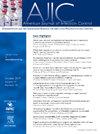Prediction models for the risk of ventilator-associated pneumonia in patients on mechanical ventilation: A systematic review and meta-analysis
IF 3.8
3区 医学
Q2 INFECTIOUS DISEASES
引用次数: 0
Abstract
Background
Identifying patients at risk of ventilator-associated pneumonia through prediction models can facilitate medical decision-making. Our objective was to evaluate the current models for ventilator-associated pneumonia in patients with mechanical ventilation.
Methods
Nine databases systematically retrieved from establishment to March 6, 2024. Two independent reviewers performed study selection, data extraction, and quality assessment, respectively. The Prediction Model Risk of Bias Assessment Tool was used to evaluate the risk of model bias and applicability. Stata 17.0 was used to conduct a meta-analysis of discrimination of model validation.
Results
The total of 34 studies were included, with reported 52 prediction models. The most frequent predictors in the models were mechanical ventilation duration, length of intensive care unit stay, and age. Each study was essentially considered having a high risk of bias. A meta-analysis of 17 studies containing 33 models with validation was performed with a pooled area under the receiver-operating curve of 0.80 (95% confidence interval: 0.78-0.83).
Conclusions
Despite the relatively excellent performance of the models, there is a high risk of bias of the model development process. Enhancing the methodological quality, especially the external validation, practical application, and optimization of the models need urgent attention.
机械通气患者呼吸机相关肺炎风险预测模型:系统回顾和荟萃分析。
背景:通过预测模型识别呼吸机相关性肺炎(VAP)风险患者有助于医疗决策。我们的目的是系统评估目前针对机械通气(MV)患者的 VAP 模型:系统检索了从建立到 2024 年 3 月 6 日的九个数据库。两名独立审稿人分别进行了研究选择、数据提取和质量评估。预测模型偏倚风险评估工具用于评估模型偏倚风险和适用性。使用Stata 17.0对模型验证的区分度进行荟萃分析:共纳入 34 项研究,报告了 52 个预测模型。50%以上的模型是通过逻辑回归建立的,所纳入模型的AUC从0.509到0.982不等。模型中出现频率较高的预测因子是 MV 持续时间、重症监护室住院时间和年龄。每项研究基本上都被认为总体偏倚风险较高。对 17 项研究进行了荟萃分析,其中包含 33 个经过验证且数据完整的模型,汇总的 AUC 为 0.80(95% CI:0.78-0.83):结论:尽管模型的性能相对较好,但模型开发过程中存在较高的偏差风险。结论:尽管模型表现相对优异,但模型开发过程中存在较高的偏倚风险,因此亟需关注提高方法学质量和揭示研究过程细节,尤其是模型的外部验证、实际应用和优化。
本文章由计算机程序翻译,如有差异,请以英文原文为准。
求助全文
约1分钟内获得全文
求助全文
来源期刊
CiteScore
7.40
自引率
4.10%
发文量
479
审稿时长
24 days
期刊介绍:
AJIC covers key topics and issues in infection control and epidemiology. Infection control professionals, including physicians, nurses, and epidemiologists, rely on AJIC for peer-reviewed articles covering clinical topics as well as original research. As the official publication of the Association for Professionals in Infection Control and Epidemiology (APIC)

 求助内容:
求助内容: 应助结果提醒方式:
应助结果提醒方式:


